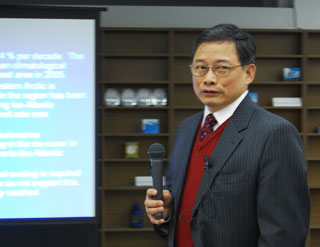for detailed information(172KB)
2008.03.21
Dr. Comiso, distinguished authority, visited to Weathernews, Global Center
January 24th, 2008, Dr. Josefino C. Comiso, a senior scientist at the Cryospheric Sciences Branch of the Goddard Space Flight Center, Greenbelt, Md. at Goddard, visited to Weathernews Global Center, in Chiba to discuss his latest research, “Accelerated Decline in the Arctic Perennial Ice Cover”. He mentioned that the perennial ice is now decreasing year and year.

Ref:Dr.Josefino C. Comiso,The Prediction of the Arctic Perennial Ice
As a distinguished authority, Dr. Comiso has been searched sea ice and polar oceanography, including climate change. He is recognized as one of the world's leading experts on sea ice of in the Arctic Ocean and satellite remote sensing.
Weathernews, as a forefront of developing undiscovered frontier; Polar Routeing, has been joint researched an optimum use of Remote Sencing data for the routing support in sea ice with Chiba University in Chiba, JAPAN. Weathernews had a great opportunity to invite Dr. Comiso since 2007, because of that he has been a fellow of the Japanese Society for the Promotion of Science and a guest professor at Chiba University. This is the second time for him to present his research in Weathernews.
The summary of Dr. Comiso's speech
- The perennial ice is now declining at 11.4% per decade. The 2007 ice minimum area was 38% less than climatological average and 27% leas than previous lowest area in 2005. This extraordinary phenomenon is the result of the global warming. The increase of greenhouse gases, such as carbon dioxide (CO2) methane (NH4), makes the Earth warm year and year.
- Conditioning: Open water area in the Western Arctic is declining at 27% decade. SST an SIT in the region has been increasing at 0.7 ℃per decade suggesting Ice-Albedo Feedback effects.
- Modeling studies, ice drift analysis, and submarine observations shows considerable thinning in the ice cover in part due to advection of thick multiyear ice to the Atlantic Ocean where they melt.
- Once the perennial ice is disappeared due to this trend, it is difficult to reform this warming condition.
- For the perennial ice to recover, sustained cooling is required both in winter and summer. Current data do not support this. The tipping point for perennial ice is likely reached.

